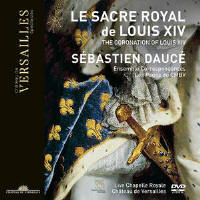Texte paru dans: / Appeared in: Château de Versailles |
|
|
Outil de traduction (Très approximatif) |
|
|
Reviewer:
J.
F. Weber
The coronation of Louis XIV at
the cathedral of Reims on June 7, 1654 must have been an occasion to
remember, for the not-yet-16-year-old had been waiting to reign for 11
years, and he would remain on the throne until 1715, the longest reign in
European history. He would be known as Le Roi-Soleil (The Sun-King). The
ceremony featured the anointing of the king using an ampulla, or glass vial,
of oil first known from the coronation of Louis VII in 1131. A legend was
created that at the baptism of Clovis by St. Rémi, bishop of Reims, in 496,
this ampulla had been brought down from heaven, and thereafter it was kept
at the abbey of St-Rémi in Reims for anointing the kings of France. Hence le
sacre royal was not the coronation but the anointing of the king, and the
crowning merely followed. Only three kings from the ninth to the 19th
century were not anointed at Reims. The ampulla was publicly destroyed in
1793, like so much else, but the oil had been removed and was later used at
the anointing of Charles X in 1825.
The royal chapel at Versailles
does not substitute for the original site, the cathedral, for it is used
simply as a concert space without any ceremonies being enacted. There is no
record of the music that was used at the cathedral, but the texts that were
sung, the order of the ceremonies, the type of ensembles, even their place
in the building have been researched. An example of making do are two
pavanes originally played for his father and predecessor, Louis XIII. A
splendid discovery is Sacris solemniis of Jean Veillot for soloists, chorus,
and orchestra, almost certainly his recording debut, sung as Louis entered
the cathedral. The Mass is Missa Vivat Rex of Charles d’Helfer, whose
Requiem was used for royal occasions as late as the funeral of Louis XV in
1774, as noted when it was recorded (Fanfare 17:6). Étienne Moulinié is
another significant composer, whose Agnus Dei is used in the Mass as well as
two motets earlier. Of the composers listed, I cannot find O rex vivat!
among the known works of Orlandus Lassus. Half a dozen chants are included,
including the familiar Unxerunt Salomonem Sadoch for the anointing. The
coronation concludes with an anonymous double-choir Te Deum. Daucé’s ensemble is a group of mixed voices and period instrumentalists that specializes in music of the French Baroque. Their recordings of Charpentier, Du Mont, and Lalande reviewed here are less than half of the dozen already issued. Also heard is the children’s choir of Versailles, placed above in the gallery, that has recorded frequently ever since the annual Baroque festivals began at Versailles over three decades ago. The seasons of Chateau de Versailles Spectacles began more recently (in 2009), resulting in this series of recordings (CDs and DVDs) made during the live performances. Only Praetorius (42:5) and the accompanying Monteverdi Vespers of 1610 have been reviewed here. Daucé is a specialist who clearly loves music of this period and knows how to produce results from his singers and players. The royal chapel has the visual excitement and the warm acoustics the make these DVDs worth experiencing repeatedly. This one is a gem. |
|




